 THIS BOOK IS FONDLY DEDICATED TO THE MEMORY OF LOUIS P. DE GOUY (18761947) BY HIS DAUGHTER JACQUELINE S. DOONER Bibliographical Note This Dover edition, first published in 2019, is an unabridged republication of the work originally published as Ice Cream Desserts for Every Occasion by Hastings House, New York, in 1938. Library of Congress Cataloging-in-Publication Data Names: De Gouy, Louis Pullig, 18691947, author. Title: The ice cream book: over 400 recipes / Louis P. De Gouy.
THIS BOOK IS FONDLY DEDICATED TO THE MEMORY OF LOUIS P. DE GOUY (18761947) BY HIS DAUGHTER JACQUELINE S. DOONER Bibliographical Note This Dover edition, first published in 2019, is an unabridged republication of the work originally published as Ice Cream Desserts for Every Occasion by Hastings House, New York, in 1938. Library of Congress Cataloging-in-Publication Data Names: De Gouy, Louis Pullig, 18691947, author. Title: The ice cream book: over 400 recipes / Louis P. De Gouy.
Other titles: Ice cream desserts for every occasion Description: Dover edition. | Mineola, New York : Dover Publications, Inc., [2019] | This Dover edition, first published in 2019, is an unabridged republication of the work originally published as Ice Cream Desserts for Every Occasion by Hastings House, New York, in 1938. Identifiers: LCCN 2018043264 | ISBN 9780486832326 | ISBN 0486832325 Subjects: LCSH: Ice cream, ices, etc. Classification: LCC TX795 .D4 2019 | DDC 641.86/2dc23 LC record available at https://lccn.loc.gov/2018043264 Manufactured in the United States by LSC Communications 82455101 2018 www.doverpublications.com Authors Foreword to the Original Edition Does ever a day go by that the homemaker doesnt ask herself, What shall I make for dessert? or How can I serve and dress up my frozen dessert? If she wants easy, economical, ever-popular answers, she will turn to ice cream, or a parfait, an ice, or a sherbet. All these will she find in this book, which suggests frozen delicacies that are not only delicious to eat, pleasing to the eye, cooling and refreshing, but supply marvelous food valuesprotein energy units, vitamins, calcium, phosphorus, and other valuable mineralsfor the enjoyment and health of her family and guests. Thousands upon thousands of American housewives are today making their own ice cream at home and, with the aid of modern freezing equipment, can produce the most delectable frozen delicacies.
Here are hundreds of these recipes for all kinds of ice cream desserts, for every day and for special occasions. You can depend upon every one of them. Many are new. Many are old time favorites. They have all been tested, checked, and rechecked. Every measurement, every step has been thoroughly considered and approved so that the result may be triumphant.
For this serviceable book, the author, a practical professional chef, has selected ingredients easily found and available on the markets throughout the United States. To the American homemaker this book is happily dedicated. L. P. De Gouy New York, N. Y.August 3rd, 1938CONTENTS SECTION I GENERAL INFORMATIONEATING AND DRINKING TO KEEP COOLGod and the doctor we alike adore,But only when in danger, not before.The danger oer, both are alike requited.God is forgotten and the doctor slighted. John Owen, English epigrammist (15601622) Both the external temperature and the internal body heat influence digestive processes.
The effect upon the system of the temperature of food and beverages is also a matter of important consideration. Hot food and beverages in cold weather, cold food and beverages in hot weather, are instinctively resorted to by almost every one, although this is, no doubt, as much due to mental association and, perhaps, a temporary agreeable sensation of the temperature in swallowing as it is to any decided influence exerted over the body temperature. One of the three Rs of nutrition that we all learned a way back in school is that food is fuel which the body uses like a furnace to generate heat. And, like a furnace we can control the generation of unnecessary amount of heat, especially in Summer, by the proper selection of food and beverages. Strange as it may seem, iced foods and beverages with ice in them actually make the body feel even hotter, by making it slave overtime to bring the temperature of these iced foods to the degree where the digestive juices can act upon them; so ice cream, sherbets, and in fact any kind of frozen dessert, should be eaten very, yes, very slowly, so that they may become well warmed in their passage to the stomach. In Summer, midday and dinner meals should contain or rather include one hot food or drink, for it is a known fact that if cold food and beverages make the body generate more heat, hot food and beverages are the signal for the body to get busy, throw off its stored-up heat, and cool off.
Of course, one should eat lightly of cooling foods. THREE TYPES OF ICE CREAM There are three general types of ice cream: French ice cream, which is a rich egg yolk custard and heavy. American ice cream, which is a less rich custard with or without flour or cornstarch, and cream or cream and milk. Philadelphia ice cream, which is a thin cream, or cream and milk and no eggs. (1) MAKING ICE CREAMFUNCTIONS OF INGREDIENTS The most important ingredients used in ice cream making are: MILK, which gives body to the mixture, the solid substances in milk holding air bubbles and preventing crystallization. The milk should always be scalded.
EVAPORATED MILK, which may be substituted for sweet milk for richness, having the same properties and action as sweet milk. It is not necessary to scald it before using. CONDENSED MILK, giving the same results as sweet and evaporated milk, plus richness of texture and certainty of sweetness. CREAM, which gives richness, smoothness, since its butter fat contents prevent crystallization. EGGS, acting as a binder, leavening, thickening, stabilizer, and giving texture as well as flavor. SUGAR, giving sweetness and at the same time preventing crystallization.
GELATINE, acting as a stabilizer, and holding ice crystals apart. MARSHMALLOWS, acting like gelatine, being a gelatine themselves. FLAVORINGS, have no effect on the freezing. FRUITS, being solids, retard the freezing process, and thus should not be added until the mixture is half solid or half frozen. NUTS, acting in the same manner as fruits. STARCH, be it flour or cornstarch, is a stabilizer because it holds the ice crystals apart.
Milk should always be scalded to reduce its water content and concentrate its protein. Evaporated and condensed milk used in ice cream making need not be scalded for the simple reason that their protein has already been concentrated during the manufacturing process, the butter fat is evenly distributed or emulsified. The amount of sugar should be carefully measured as too sweet a mix will delay the freezing. Cream should be added when half beaten, or to a fluffy texture, the consistency of boiled custard. Gelatine and marshmallows should be always dissolved. Ice cream to be smooth, that is, free of crystals, must be frozen quickly, so the control should be set in the coldest position, and, as soon as the mixture is frozen, the control should be turned back to normal, lest the ice cream become too hard.
An important point to be remembered is that all the ingredients used in ice cream making should be chilled thoroughly before combining them. If water is used in the recipe, the mixture should be beaten when it is frozen to a stiff mush, as this will break up any crystals that may have formed. ( 2) HOW TO USE A HAND FREEZER There are many patterns of ice cream freezers that are well constructed and inexpensive. They are sold by the size, a No. 2quart freezer giving you two quarts of the frozen cream or ice. See that the crank is oiled and the whole apparatus clean.
Have ready cracked ice and rock salt, usually in the proportion of 1 part salt to 3 parts of cracked ice (snow may be used). Shavers or mallet or machines come for cutting the ice, but it is easy to pound or crack it in a strong bag or burlap. Set the freezer can in place, which should be well-chilled, put around it the ice and coarse rock salt alternately, shaking down and packing firmly. Have the ice cream mixture cool, pour it in, having the can not more than full, to allow for expansion. Put on the lid, cover with ice and salt, wait 5 short minutes, and begin to turn the crank. Open and stir down once or twice, being careful to keep out the salt, lest the cream mixture may be spoiled.
Next page
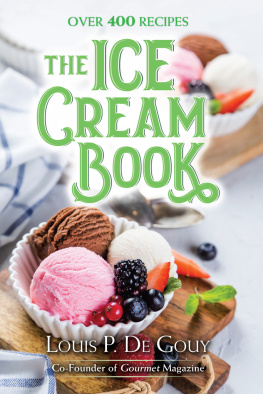
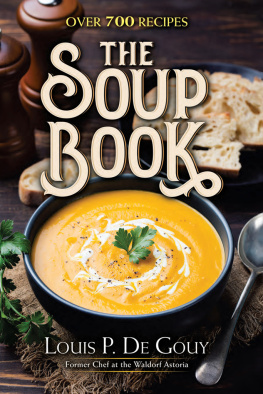
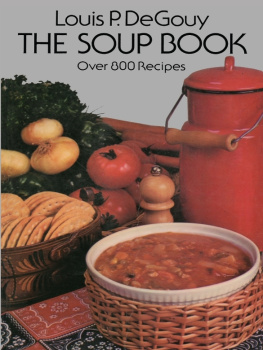

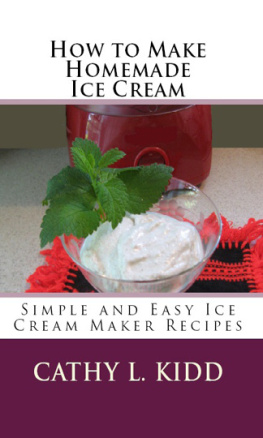
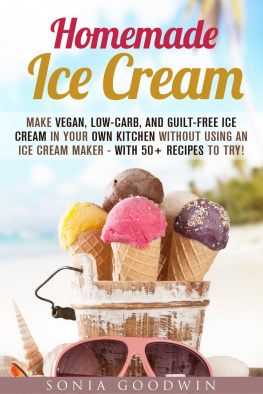
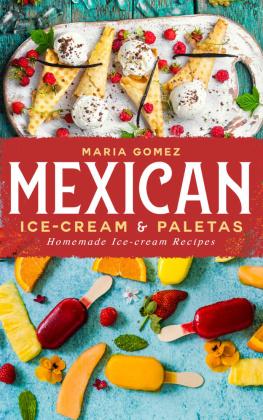
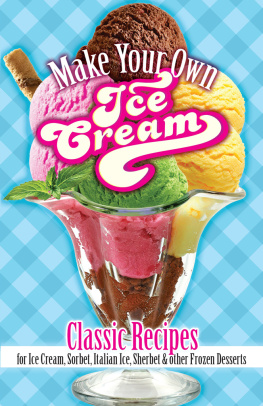


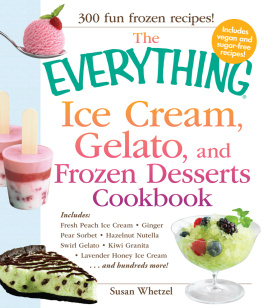
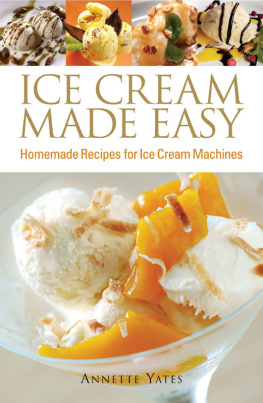
 THIS BOOK IS FONDLY DEDICATED TO THE MEMORY OF LOUIS P. DE GOUY (18761947) BY HIS DAUGHTER JACQUELINE S. DOONER Bibliographical Note This Dover edition, first published in 2019, is an unabridged republication of the work originally published as Ice Cream Desserts for Every Occasion by Hastings House, New York, in 1938. Library of Congress Cataloging-in-Publication Data Names: De Gouy, Louis Pullig, 18691947, author. Title: The ice cream book: over 400 recipes / Louis P. De Gouy.
THIS BOOK IS FONDLY DEDICATED TO THE MEMORY OF LOUIS P. DE GOUY (18761947) BY HIS DAUGHTER JACQUELINE S. DOONER Bibliographical Note This Dover edition, first published in 2019, is an unabridged republication of the work originally published as Ice Cream Desserts for Every Occasion by Hastings House, New York, in 1938. Library of Congress Cataloging-in-Publication Data Names: De Gouy, Louis Pullig, 18691947, author. Title: The ice cream book: over 400 recipes / Louis P. De Gouy.